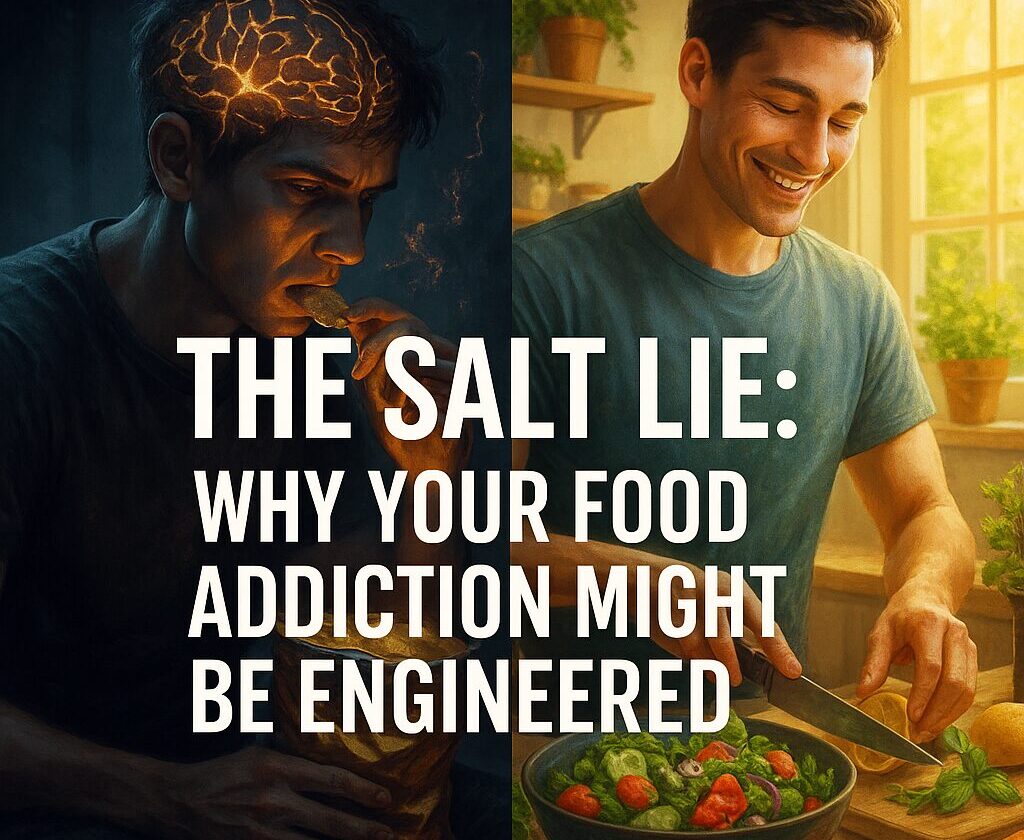You’re Not Addicted to Food—You’re Being Manipulated
Have you ever reached for a snack, even when you weren’t hungry? Finished a bag of chips and still craved more? Felt like food has control over you, no matter how hard you try to “eat clean”?
You’re not broken. You’re not weak.
Your food might be engineered to keep you hooked.
At the heart of this manipulation lies an unlikely suspect: salt. Not sugar. Not fat. Salt.
This isn’t just about blood pressure or bloat. This is about neurochemistry, addiction cycles, and corporate strategy that profits when your cravings control you. In this deep dive, we’ll unpack how high-sodium processed foods hijack your brain, why they’re designed to override your fullness signals, and how to break free with low-sodium alternatives that actually satisfy.
Section 1: Salt, Dopamine & the Brain’s Reward System
The Science of Addiction:
When we talk about food addiction, sugar often takes the blame. But recent research shows salt stimulates the brain’s dopamine system — the same reward circuit activated by nicotine and alcohol.
Dopamine isn’t just about pleasure. It’s about anticipation and motivation. The more salt-laden food you eat, the more your brain lights up in response. This creates a craving loop that makes you want more, even when your body has had enough.
“Sodium activates opioid receptors and dopamine release. Over time, this response can condition us to seek out salty foods compulsively.”
— Dr. Paul Breslin, Rutgers University, sensory scientist
Why It’s Dangerous:
- You begin to need more salt to feel satisfied.
- Cravings become habitual, tied to stress, boredom, or reward.
- Your baseline for flavor shifts, making real, whole food taste bland by comparison.
References:
- Breslin, P. A. (2013). An evolutionary perspective on food and human taste. Current Biology, 23(9), R409-R418.
- Liem, D. G., & Russell, C. G. (2019). The influence of taste liking on the consumption of nutrient rich and nutrient poor foods. Frontiers in Nutrition, 6, 174.
Section 2: Salt + Fat + Crunch = Engineered Bliss Point
Salt isn’t acting alone. It’s often paired with refined fats, starches, and textures to create what’s called the “bliss point” — the exact combination of saltiness, mouthfeel, and crunch that maximizes pleasure and overrides satiety.
This formula isn’t accidental.
Food scientists at major brands run tests with focus groups, adjusting seasoning blends until they find the point where the brain lights up — and won’t stop.
“Processed foods are engineered to be hyper-palatable. The goal isn’t nutrition — it’s repeat consumption.” — Dr. Michael Moss, author of “Salt Sugar Fat: How the Food Giants Hooked Us”
Results:
- You keep eating, even after fullness
- You feel addicted, out of control
- You blame yourself for a biochemically designed trap
References:
- Moss, M. (2013). Salt Sugar Fat: How the Food Giants Hooked Us. Random House.
- Gearhardt, A. N., & Corbin, W. R. (2009). Preliminary validation of the Yale Food Addiction Scale. Appetite, 52(2), 430-436.
Section 3: Salt, Stress, and Emotional Eating
When you’re stressed, your brain craves comfort. High-sodium foods light up the hypothalamus, reduce cortisol, and temporarily trigger a “calm” signal.
But it doesn’t last.
You’re left with a crash, more cravings, and higher blood pressure. It becomes a cycle of emotional suppression through food, reinforced by salt.
Signs You’re Trapped:
- Salty foods are your go-to stress snack
- You feel anxious or irritable without salty snacks
- You eat chips, fries, or processed meats even when not hungry
Salt becomes a form of self-soothing, but it ultimately makes emotional regulation harder.
References:
- Farquhar, W. B., et al. (2015). Dietary sodium and health. Journal of the American College of Cardiology, 65(10), 1042-1050.
- Epel, E. S., et al. (2001). Stress and body shape: stress-induced cortisol secretion is consistently greater among women with central fat. Psychosomatic Medicine, 63(4), 625-632.
Section 4: Breaking Free Without Losing Flavor
Breaking up with salt doesn’t mean living on bland food. It means retraining your palate and rebuilding your meals with flavor and healing in mind.
Here are sodium-smart swaps that deliver satisfaction without hijacking your brain:
? Instead of: Flavored chips, try…
- Roasted chickpeas with smoked paprika + garlic powder
- Kale chips baked with olive oil, lemon zest + cumin
? Instead of: Processed frozen meals, try…
- Homemade grain bowls with fresh herbs, tahini, lemon juice, and roasted veggies
- Batch-cooked soups using salt-free broth + vinegar for brightness
? Instead of: Deli meats and cheese, try…
- Fresh roasted turkey or chicken with rosemary + citrus
- Hummus with cucumber slices and za’atar spice
Flavor-Focused Seasonings That Heal:
- Smoked paprika (depth, richness)
- Lemon zest + juice (brightness)
- Garlic, onion, and chili powder (body + heat)
- Fresh herbs (anti-inflammatory, aromatic)
These swaps satisfy cravings while retraining the brain, helping your body heal from chronic sodium overload.
Conclusion: You’re Not the Problem. The System Is.
If you’ve struggled with salty cravings, binge eating, or feeling addicted to food you don’t even like… you’re not alone. And you’re not weak.
You’re operating in a food environment designed to profit off your cravings.
Salt is part of that trap. But you can break out.
By lowering sodium, retraining your taste buds, and embracing whole-food flavor, you reclaim your power, your palate, and your peace.
Want recipes that deliver real flavor without the manipulation? Try Recipe Shop free for 2 weeks.
Full access. No credit card. Just food that works for you, not against you.

